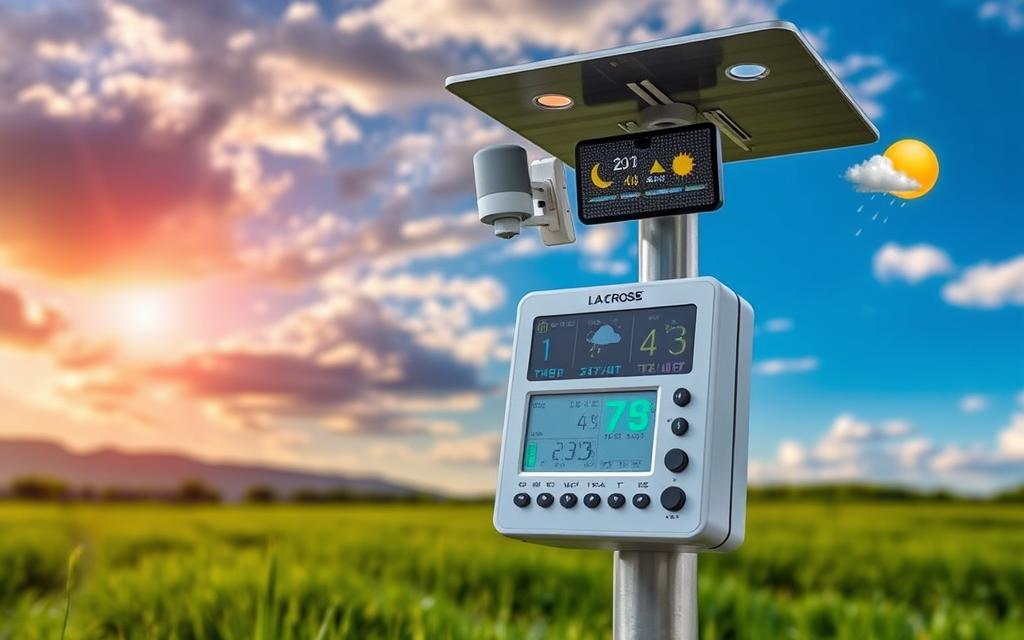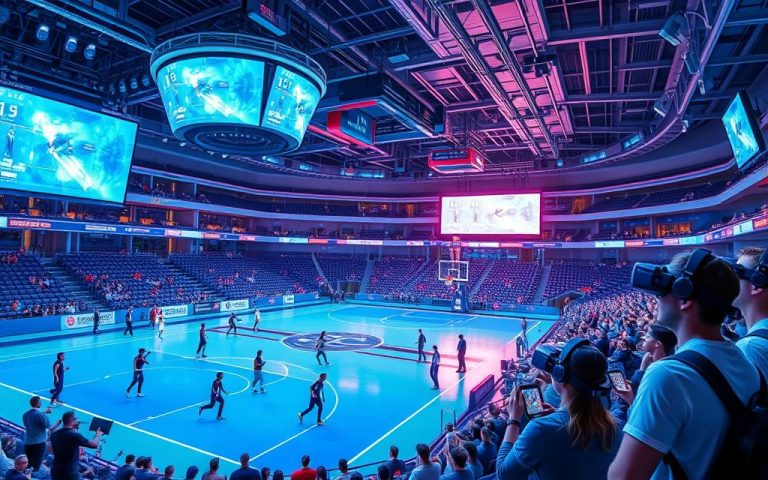How to Program Your La Crosse Technology Weather Station: A Simple Guide
To get the most out of your La Crosse Technology weather station, you need to program it right. This guide will show you how to do it. We’ll cover the basics of setting up your weather station and how to program it step by step.
If you’d rather have a digital copy of the manual, you can find one here. Just visit the La Crosse Technology weather station manual. It has all the details you need for programming and setting up your station.
Your La Crosse Technology weather station has lots of features. It can measure outdoor temperatures from -40°F to 140°F (-40°C to 60°C). It also tracks indoor humidity from 10% to 99%RH. This makes it a must-have for anyone who loves weather.
Understanding Your La Crosse Technology Weather Station
The La Crosse View wireless weather station gives you accurate weather data. It has a display console, sensor array, and wireless connectivity. This lets you monitor the weather remotely through the La Crosse View app.
The display console shows the current weather, like temperature and humidity. The sensor array collects data from outside and sends it to the console. You can then see this data on the La Crosse View app and get alerts.
Key Components and Features
The La Crosse View wireless weather station has many features. It lets you monitor the weather from anywhere, get unlimited alerts, and export data. It’s a must-have for anyone who wants to know the weather.
Display Console Overview
The display console is key to the La Crosse View system. It shows the weather clearly, with details like temperature and humidity. It helps you stay up to date with the weather easily.
Sensor Array Introduction
The sensor array is vital for the La Crosse View system. It gathers data from outside and sends it to the console. This way, you get accurate weather data. With the La Crosse View app, you can see this data anywhere and get alerts.
Essential Preparation Steps Before Programming
To make sure your weather station preparation goes well, follow the maker’s instructions closely. This is especially true for La Crosse Technology setup. Start by unpacking the device carefully, checking for any damage. Also, make sure all parts are there.
It’s important to put the weather station in the right spot. It should be away from things that might block the signal. The quick start guide and manuals that come with it are full of useful tips for weather station preparation and La Crosse Technology setup.
Some key steps to take during preparation are:
- Unpacking and checking the device for any damage
- Checking that all parts, like sensors and the display console, are there
- Putting the weather station in a spot where it gets the best signal
- Getting all parts ready for La Crosse Technology setup
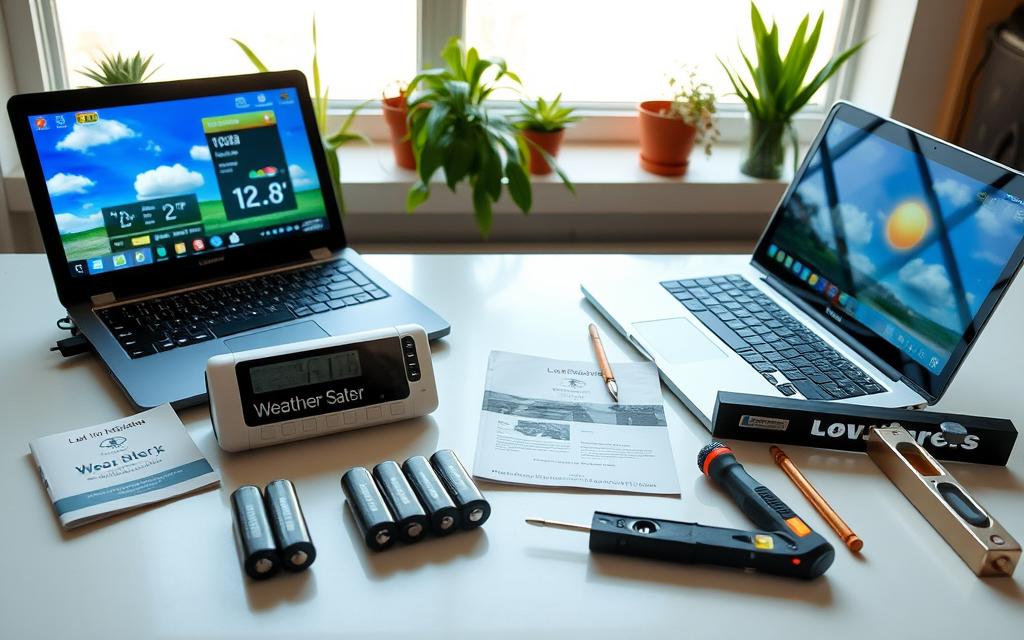
By following these steps, you can make sure your weather station preparation and La Crosse Technology setup go smoothly. This will help you get accurate and reliable weather readings.
How to Program La Crosse Technology Weather Station: Basic Setup
To start using your La Crosse Technology weather station, you need to set it up first. This means putting in the right batteries and going through the first power-up steps. You’ll need 3 “AAA” batteries for the station and 2 “AA” batteries for the sensor. Make sure to put the batteries in the right spots as shown in the manual to avoid problems.
After putting in the batteries, start the first power-up. If you don’t see the outdoor temperature after 3 minutes, you might need to restart. This involves unplugging the power cord, taking out the batteries, and pressing any button 20 times. It’s very important to follow the maker’s instructions for programming weather stations like this one.
Setting up also means syncing your sensors for precise readings. The La Crosse Technology weather station can handle up to 5 thermo-hygrometers. This lets you show 5 different temperature and humidity levels. To sync the sensors, check the manual for the exact steps. You’ll need to put in the sensor batteries and wait for the device to find the sensor.
- Install 3 “AAA” batteries in the weather station
- Install 2 “AA” batteries in the sensor
- Complete the initial power-up sequence
- Synchronize the sensors for accurate readings
By doing these steps, you’ll get your La Crosse Technology weather station set up. Then, you can start tracking the weather in your area.
Setting Time and Date Parameters
Getting the time and date right is key for your weather station to work well. To get the most accurate readings, setting the time and date correctly is vital. You can do this manually or by adjusting the time zone and date format.
Manual Time Configuration
Manual time setting lets you set the time and date based on where you are. Just follow the steps in the user manual. Make sure the time and date are right to avoid any weather reading errors.
Time Zone Adjustments
Adjusting the time zone is important to match your location’s time and date. Choose the right time zone from the options given. Remember, changing the time zone can impact the accuracy of your weather readings.
Date Format Options
Date format options let you pick how you want to see the date. You can choose from different formats like day/month/year or month/day/year. Pick a format that’s easy to read and understand.
The following table summarizes the key points to consider when setting time and date parameters:
| Parameter | Description |
|---|---|
| Manual Time Configuration | Set time and date manually according to location |
| Time Zone Adjustments | Adjust time zone to align with location |
| Date Format Options | Choose date format from available options |
Configuring Weather Measurements
To get the most out of your La Crosse Technology weather station, it’s key to set up the weather measurements right. This means setting the temperature, humidity, and other weather details for accurate readings. The setup is easy, and with the right help, you can start using your weather station quickly.
The La Crosse Technology weather station model 308-1414B/308-1414W has many features. These include 12/24 hr. atomic time and signal strength for sensor transmission. You also get animated forecast icons. To use these, insert the batteries correctly and plug in the 5-volt AC power adapter.
Some important weather measurements to set up include:
- Outdoor temperature with trend indicator
- Indoor humidity with trend indicator
- Customizable temperature alerts
These features let you keep up with the weather. You get real-time updates and alerts. La Crosse Technology ensures your weather measurements are precise and trustworthy, using over one billion real-time data points.
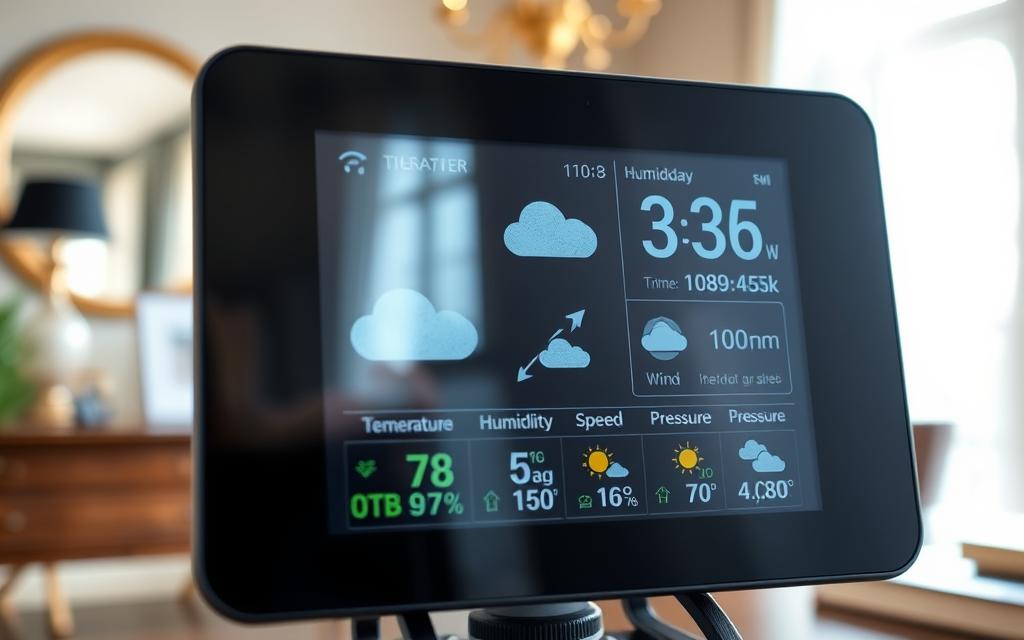
By following the manufacturer’s guide and setting up your weather station right, you’ll get accurate and reliable weather measurements. This is great for anyone who loves weather or just wants to stay updated. The La Crosse Technology weather station is a top choice, giving you the data you need to make smart choices.
Programming Temperature and Humidity Settings
Programming your La Crosse Technology weather station is key for accurate readings and comfort. The indoor station works best between 32°F to 122°F (0°C to 50°C). Make sure to set the temperature unit to either Fahrenheit or Celsius.
To change the temperature unit, follow these steps:
- Access the weather station’s menu
- Scroll to the temperature settings option
- Select the desired temperature unit
Humidity alarms can also be set up. They alert you when humidity levels get too high. This helps keep your comfort levels just right.
When the temperature is between 68˚F and 79˚F, and humidity is 45% to 64%, you’ll see a “happy-face”. This shows you’re in a comfortable zone. Here’s a table that shows when you’re comfortable:
| Temperature Range | Humidity Range | Comfort Level Indicator |
|---|---|---|
| 68˚F – 79˚F | 45% – 64% | Happy-face |
By setting up your weather station correctly, you’ll always know the current conditions. This lets you stay comfortable.
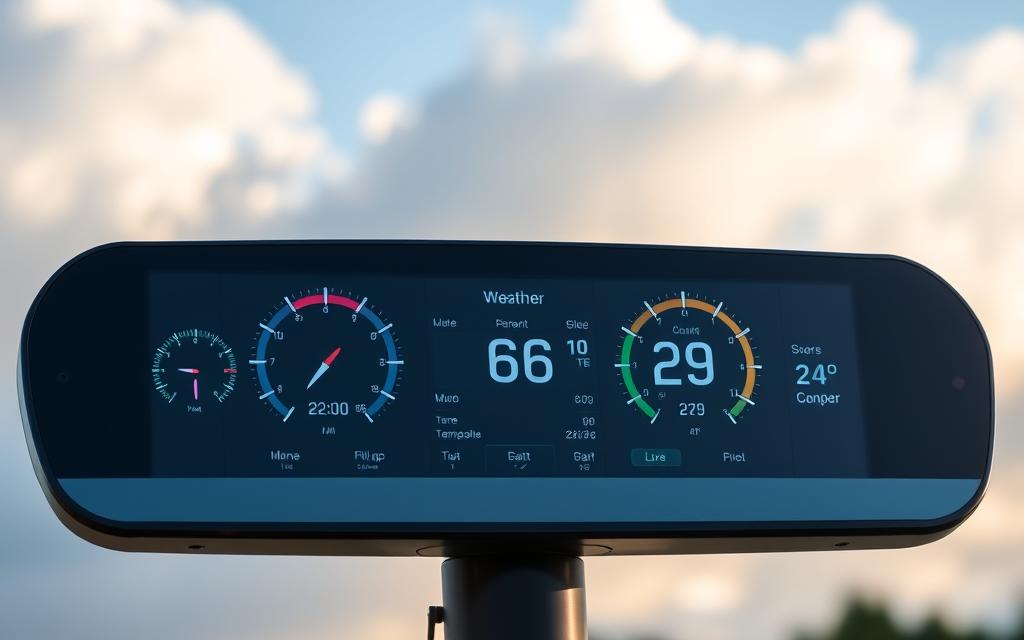
The weather forecasting feature is about 75% accurate, based on air pressure changes. With the right settings, you’ll be ready for any weather.
Setting Up Weather Alerts and Alarms
To keep up with the weather, setting up weather alerts and alarms is key. The La Crosse View app lets users set up alerts for things like temperature, humidity, and wind. For more on setting up your weather station, check out the La Crosse Technology support page.
Some important features of the weather station include:
- Customizable weather alerts for temperature, humidity, and wind
- Adjustable alarms for high and low temperatures
- Option to receive push notifications and email alerts
To setup weather alerts and alarms, follow these steps:
- Open the La Crosse View app and go to the settings menu
- Pick the alert or alarm you want to set up
- Choose when you want to get notifications
| Alert Type | Conditions | Notification Options |
|---|---|---|
| Temperature Alert | High or low temperature | Push notification, email alert |
| Humidity Alert | High or low humidity | Push notification, email alert |
Setting up weather alerts and alarms helps you stay updated on the weather. With the La Crosse View app, it’s simple to customize your setup. This way, you get the alerts that are most important to you.
Calibrating Your Weather Station
To get accurate readings from your weather station, calibration is key. This means adjusting settings to match the current weather. It’s important to calibrate temperature, pressure, and rainfall to get reliable data.
The first step is temperature calibration. You need to set the temperature unit to Celsius or Fahrenheit. Then, pressure calibration is done to ensure accurate rainfall readings. This process can take weeks, depending on your weather station model.
A calibrated weather station gives you accurate rainfall data. This is crucial for understanding how much rain falls. By following your user manual, you can make sure your station gives you the right data.
| Calibration Type | Description |
|---|---|
| Temperature Calibration | Set temperature unit to Celsius or Fahrenheit |
| Pressure Calibration | Adjust pressure settings for accurate rainfall measurements |
| Rainfall Calibration | Ensure accurate rainfall measurements |
By following these steps, your weather station will give you accurate data. This is vital for predicting the weather.
Maintaining Accurate Readings
To keep your weather station giving accurate readings, regular maintenance is key. This means cleaning the sensors, updating the software, and checking the device often.
A well-kept weather station is vital for getting trustworthy data. By sticking to the maker’s guide and doing regular checks, you can make your device last longer. This ensures it keeps giving accurate readings.
Here are some important maintenance tips:
- Regularly clean the sensors to stop dirt and debris from messing with accurate readings
- Update the software to get the newest features and fixes
- Do routine checks on the device to spot any problems
By sticking to these tips and doing regular maintenance, you can make sure your weather station keeps giving accurate readings and reliable data.
Remember, a well-kept weather station is crucial for getting reliable data and accurate readings. By following the maker’s guide and doing regular checks, you can extend your device’s life. This ensures it keeps giving you valuable info.
| Maintenance Task | Frequency | Importance |
|---|---|---|
| Cleaning sensors | Weekly | High |
| Updating software | Monthly | Medium |
| Performing routine checks | Daily | High |
Troubleshooting Common Programming Issues
When you program your La Crosse Technology weather station, you might face some problems. It’s important to solve these issues to get accurate readings. First, find out what’s causing the problem. It could be with the programming, sensor connection, or the display.
Poor signal reception is a common issue. It might be due to obstacles or other devices interfering. Try moving the sensors or using a signal repeater to improve the signal. Also, make sure the sensors are connected well to the base station and the batteries are new.
Signal Reception Problems
Dealing with signal reception issues can be tough. But, there are ways to fix it. First, check if the sensor’s signal is strong enough. It should be close to the base station. If not, try resetting the sensor or the base station to fix any connection problems.
Display Issues
Display problems can stem from wrong settings or faulty parts. Check your display settings to make sure they’re right. Try resetting the display to its default settings. If it still doesn’t work, you might need a new display or more help from the user manual.
Sensor Connectivity Solutions
Problems with sensor connection can be fixed by checking the connection to the base station. Make sure it’s paired correctly. Try restarting the sensor or resetting the base station. For more help, look at the user manual.
By following these steps, you can fix common problems with your La Crosse Technology weather station. Always check the user manual for specific advice on fixing and maintaining your device.
| Issue | Troubleshooting Steps |
|---|---|
| Poor signal reception | Reposition sensors, use signal repeater, check battery levels |
| Display issues | Check display settings, reset display, consult user manual |
| Sensor connectivity problems | Check sensor connection, restart sensor, reinitialize base station |
Conclusion: Making the Most of Your Weather Station
By following the steps in this guide, you can now get the most out of your La Crosse Technology weather station. You’ve learned how to set it up and calibrate the sensors. This ensures your station gives you accurate, real-time weather data.
It’s important to place and maintain the weather station’s parts correctly. Check the sensor connections, replace batteries when needed, and recalibrate the device. This will help you enjoy reliable readings for a long time. You can track temperature, humidity, barometric pressure, and rainfall. This helps you make better decisions and prepare for weather changes.
Use the station’s connectivity features and mobile apps to stay updated anywhere. You’ll get weather alerts that fit your needs. With your La Crosse weather station, you’ll have access to lots of data and forecasts. This makes your investment in home weather monitoring worthwhile.
FAQ
What are the key components and features of the La Crosse Technology weather station?
The La Crosse Technology weather station has a display console and a sensor array. The display shows all the weather data. The sensor array collects the needed measurements.
What are the essential preparation steps before programming the La Crosse Technology weather station?
First, unpack the weather station. Then, place it where you want it. Make sure all parts are ready for setup.
How do I install the batteries and complete the initial power-up sequence for the La Crosse Technology weather station?
Start by putting in the batteries right. Then, follow the power-up sequence. This syncs the sensors for precise readings.
How do I configure the time and date settings on the La Crosse Technology weather station?
You can set the time manually. Adjust the time zone and choose a date format. This keeps the station working well.
How do I configure the weather measurements on the La Crosse Technology weather station?
You can adjust settings for temperature and humidity. This ensures the weather station measures accurately.
How do I program the temperature and humidity settings on the La Crosse Technology weather station?
Pick the right temperature unit. Set up humidity alarms and comfort level indicators. This personalises your weather station.
How do I set up weather alerts and alarms on the La Crosse Technology weather station?
The station has many customisable alerts and alarms. You can set up notifications that suit you.
How do I calibrate the La Crosse Technology weather station for accurate readings?
Calibrate for temperature, pressure, and rainfall. This ensures the readings are precise.
What maintenance is required to keep the La Crosse Technology weather station providing accurate readings?
Clean the sensors regularly. Also, update the software if needed. This keeps the readings accurate.
How do I troubleshoot common programming issues with the La Crosse Technology weather station?
You might face signal, display, or sensor problems. Follow the troubleshooting steps to fix these issues.

